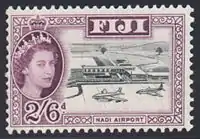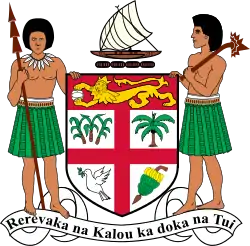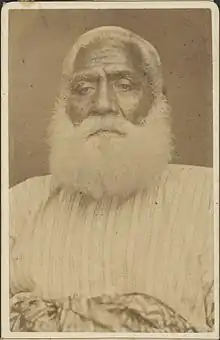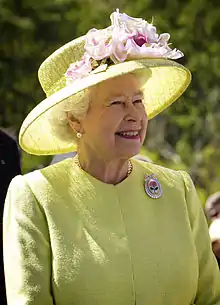Monarchy of Fiji
The monarchy of Fiji arose in the mid-nineteenth century when native ruler Seru Epenisa Cakobau consolidated control of the Fijian Islands and declared himself King or paramount chief of Fiji (Fijian: Tui Viti). In 1874, he voluntarily ceded sovereignty of the islands to Britain, which made Fiji a Crown colony within the British Empire. After nearly a century of British rule, Fiji became a Dominion, an independent sovereign state within the Commonwealth of Nations with Elizabeth II as head of state. After a second military coup in 1987 led by Lieutenant Colonel Sitiveni Rabuka, Fiji became a republic, and the monarchy was ended. Nevertheless, the Great Council of Chiefs recognised Elizabeth II as Tui Viti or the traditional Queen of Fiji, but the position is not one of a constitutional, or otherwise legal nature. The Great Council of Chiefs was disestablished in 2012 by decree of President Ratu Epeli Nailatikau. Elizabeth II does not use the title, and the Fijian government does not recognise it.
| Monarchy of Fiji | |
|---|---|
 Queen Elizabeth II on a Fijian stamp | |
| Details | |
| First monarch | Seru Epenisa Cakobau |
| Last monarch | Queen Elizabeth II |
| Formation | 5 June 1871 |
| Abolition | 6 October 1987 (1987 Fijian coups d'état) |
 |
|---|
| This article is part of a series on the politics and government of Fiji |
Origins
In the late 1840s, the Vunivalu or ruler of Bau, Tanoa Visawaqa (died 1852) declared himself Tui Viti, which translates as "King of Fiji" or "paramount chief of Fiji". It is recorded that he used the title in recognition of his political influence over other chiefly states, for instance in Rewa, where he was "Vasu-Levu" (high ranking matrilineal descendant), Naitasiri, Cakaudrove and Lau, where he had forged strong alliances, and in Macuata, where he was able to effectively intervene in the feuds of the ruling family to establish an ally as Tui Macuata or "paramount chief of Macuata". As the title was never a traditional one, and as Bauan influence did not extend to the whole of Fiji, Tanoa Visawaqa's claim to it is often viewed by historians as self-proclaimed, driven by astute ambition which would to a certain degree work to the advantage of his successor, his son Seru Epenisa, known as "Cakobau", or "destroyer of Bau".
Seru Cakobau ruled the short lived Kingdom of Fiji (1871–1874) as Tui Viti, and the title became synonymous with him. Even before the formation of the Kingdom of Fiji, Seru Cakobau is recorded to have used the title. In 1854, as Tui Viti, he attended a court conducted by Captain Denham of HMS Herald into Cakobau's alleged misdeeds against the Europeans. The usage of the title brought both advantages and disadvantages to the holder. Advantages in that it allowed Cakobau to deal with the Europeans and control the new wealth and technology they brought with them and disadvantages in being held responsible for the actions of Fijians beyond his realm of control. It was the latter in tandem with his claims to the title and European claims for monetary compensation that would contribute to his reasons for ceding Fiji to Britain in 1874. Even though Seru Cakobau was not recognised by all Fijians as King of Fiji, his use of the title, and its recognition by many of the leading chiefs, led European settlers and foreign powers to treat him as a native king.
British sovereignty
Seru Cakobau was the lead signatory on the deed of cession that granted Britain sovereignty over the islands in 1874. After cession to the British Empire in 1874, historical records refer to Seru Cakobau as only Vunivalu of Bau, or Ratu Seru Cakobau, indicating the title Tui Viti was lost when the sovereignty of Fiji was ceded to the British Crown. When Ratu Seru Cakobau signed the deed of cession he also presented his war club to Queen Victoria, the British monarch, as a symbol of his submission and loyalty. The presentation of the war club, named Na Tutuvi Kuta nei Radi ni Bau (The sleeping cover of the Queen of Bau) refers to the traditional duty of the Vunivalu to protect the principal wife of the Rokotui Bau and can again be taken to mean Cakobau accepted protection from Queen Victoria and her successors.
Dominion
In 1970, 96 years of British rule came to an end, and Fiji became an independent sovereign state within the Commonwealth of Nations. The official name of the state was the "Dominion of Fiji".[1][2] Fiji's Head of State was Elizabeth II, who was represented by a Governor-General and was also queen of other countries, such as Australia, Canada, New Zealand, and the United Kingdom. The queen's realms were all independent from one another, and the Queen acted independently in each realm, but they shared the same person as monarch. As a constitutional monarchy, executive power was held by a prime minister, usually the leader of the majority party in an elected legislature. The prime minister was appointed by the Governor-General.
Republic
On 14 May 1987, a coup led by Sitiveni Rabuka resulted in the overthrow of the government of Fijian Prime Minister Timoci Bavadra, elected at the 1987 Fijian general election.[3]
The Fijian Supreme Court ruled the coup unconstitutional, and the Queen's representative, the Governor-General of Fiji Ratu Sir Penaia Ganilau, unsuccessfully attempted to assert executive power. He opened negotiations, known as the Deuba Talks, with both the deposed government and the Alliance Party, which most indigenous Fijians supported. These negotiations culminated in the Deuba Accord of 23 September 1987, which provided for a government of national unity, in which both parties would be represented under the leadership of the Governor-General.[4]
Fearing that the gains of the first coup were about to be lost, Rabuka staged a second coup on 25 September, abolished the monarchy on 6 October, and declared Fiji a republic.[5] Penaia Ganilau resigned as Governor-General on 15 October 1987, and Fiji was expelled from the Commonwealth of Nations.
Ten years later, after constitutional talks and an election, Sitiveni Rabuka, who instigated the two military coups, presented a tabua, a tooth of a sperm whale, to Queen Elizabeth during the Commonwealth Heads of Government conference in Edinburgh, Scotland. This gesture from Rabuka, by now the Prime Minister of Fiji, is a traditional sign of profound respect and was given as an apology for having broken his oath of allegiance to her as an officer of the Military of Fiji. The agreed Constitution of 1997 provided for a President as Head of State of a Fijian republic, with the President chosen by the Great Council of Chiefs, a formal body of mostly hereditary chiefs.
Current position
Though Fiji has been a republic since 1987 and was suspended from the Commonwealth for a second time in 2009, until 2012 the Queen's effigy was still displayed on Fiji's currency and the Queen's Official Birthday remained a public holiday. In 2012, Frank Bainimarama's government abolished the official birthday holiday,[6] and replaced the Queen's image on banknotes and coins with indigenous flora and fauna.[7][8] The St Edward's Crown still forms part of the badges of the military and the police. The Queen and the royal family retain widespread affection among the Fijian people, and there have also been sporadic public debates on whether to return to a constitutional monarchy. The motto of the republic remains "Fear God and honour the King" (or "Queen"[9]) (Fijian: Rere vaka na kalou ka doka na Tui), which was adopted by Cakobau in 1871.[10] The country's coat of arms remain unchanged.
In 1998, the Great Council of Chiefs debated Elizabeth II's role as "supreme tribal chief".[11] In 2002, on behalf of the Council, the Council's chairman, Ratu Epeli Ganilau, the son of Ratu Sir Penaia Ganilau, declared that Elizabeth II was still the traditional Queen or paramount chief of Fiji or Tui Viti, even though this position no longer conferred any constitutional prerogatives and it was "not widely known that she is the paramount chief of Fiji in the traditional sense; only some of the council members remembered her status".[12][13][14] The majority of the members of the Council were descendants and blood relatives of the chiefs who ceded Fiji to Queen Victoria, Elizabeth's great-great-grandmother, in 1874. Consequently, while Fiji is a republic, a monarch or paramount chief was recognised by traditional tribal structures.
As Queen Elizabeth II has made no official claim to the Tui Viti title, and it is not officially recognised by the current de facto Fijian government, it remains dormant in usage. When broached on the subject of restoration by Sitiveni Rabuka during a meeting with the Queen in 1997, her response was simple: "Let the people decide".[15]
After another coup in 2000, further political tension led to a fourth coup in 2006. The Great Council of Chiefs was suspended in 2007,[16] and the Constitution, which gives the Council the right to appoint the Head of State from among its members, was suspended in 2009. On 14 March 2012, the Council was formally de-established.[17]
In the last two decades since Fiji became a republic, the question on restoring the monarchy has not abated. The current Prime Minister Frank Bainimarama displays portraits of the Queen and her consort, Prince Philip, Duke of Edinburgh, above his office desk. He has also described himself as a monarchist: "I'm still loyal to the Queen. Many people are in Fiji. One of the things I'd like to do is see her restored as our monarch, to be Queen of Fiji again."[18] To date, no referendum has ever been called to decide on the question of restoration.
List of Fijian monarchs
| Name | Portrait | Birth | Marriages | Death |
|---|---|---|---|---|
| Seru Epenisa Cakobau 5 June 1871[nb 1] – 10 October 1874 (Throne ceded) |  | 1815 Lakeba, Lau Islands son of Ratu Tanoa Visawaqa and Adi Savusavu[19] | Adi Litia Samanunu (1st wife) Adi Salote Qalirea Kaunilotuna (2nd wife) 8 children[19] | 1 February 1883 aged c. 68[19] |
| Elizabeth II 10 October 1970[20] – 6 October 1987 (Republic declared) |  | 21 April 1926 Mayfair daughter of George VI and Elizabeth Bowes-Lyon | Lieutenant Philip Mountbatten, Duke of Edinburgh Westminster Abbey 20 November 1947 4 children |
See also
- List of heads of state of Fiji
- Ancient Monarchy of Fiji in Roko Tui Bau
Notes
- Cakobau had been the Vunivalu (Warlord/Paramount chief) of Bau since 1852. He had long styled himself the Tui Viti (King) of Fiji, but had not been recognized as such by other Ratu (Fijian chiefs), and he exercised no direct authority outside Bau until he unified the country under his rule 1871. His ancestors, going back as far as 1770, have often erroneously been listed as Kings of Fiji. For more details about this period of Fijian history, see Fiji during the time of Cakobau.
References
- U.S. Department of State (1975) Countries of the world and their leaders, Gale Research Co., ISBN 0-8103-1046-5, p. 405
- Handbook of Fiji, Pacific Publications, 1972, pages 6-7
- Lal 2010, p. 350.
- Lal 2010, p. 390.
- "Historical timeline". Fiji Government. 13 September 2009. Archived from the original on 13 September 2009.
- "Fiji Scraps Queen's birthday holiday". NewstalkZB. 31 July 2012.
- "Anger over plan to remove Queen from Fiji money". Australian Broadcasting Corporation. 12 December 2012. Archived from the original on 28 July 2013.
- "Fiji's new flora and fauna design banknotes and coins". Reserve Bank of Fiji. 25 October 2013. Archived from the original on 27 July 2013.
- "Our country: National symbols" Archived 23 March 2010 at the Wayback Machine, government of Fiji
- Smith, Whitney (1980). Flags and Arms across the World, London: Cassell, p. 250, ISBN 0-304-30659-2
- "Fiji votes to make Queen 'supreme tribal chief'", Robert Keith Reid, The Independent, 20 July 1998
- "Fiji chiefs say Britain's Elizabeth still Queen of Fiji". Radio New Zealand International. 19 November 2002. Retrieved 26 October 2011.
- "Queen still chief of Fiji", Sydney Morning Herald, 20 November 2002
- "Britain's queen is still the 'king of Fiji'", IOL, 20 November 2002
- "Still the Queen of Fiji?", AOL Canada, retrieved 23 November 2009
- "Fiji coup leader sacks chiefs". Television New Zealand. Reuters. 12 April 2007. Archived from the original on 6 October 2012. Retrieved 26 October 2011.
- http://www.stuff.co.nz/world/south-pacific/6573396/Fijis-Great-Council-of-Chiefs-abolished
- Despot for diversity, The Australian, May 1, 2009
- VUNIVALU of BAU
- Elizabeth II became Queen on 6 February 1952, assuming the thrones of the United Kingdom and six other independent countries. Fiji, a Crown colony since its annexation in 1874, was considered a British possession and was under the sovereignty of the Crown. From Fiji's independence on 10 October 1970, the link between the British monarchy and Fiji officially ended, and Elizabeth II became Queen of Fiji, a position independent of her role as British Sovereign. Between 1970 to 1987, the Dominion of Fiji was one of many independent states headed by Elizabeth II.
Sources
- Lal, Brij V. (2010), In the Eye of the Storm Jai Ram Reddy and the Politics of Postcolonial Fiji (PDF), Canberra: Australian National University, ISBN 9781921666520
- Mosese Bulitavo (25 September 2015). "The Politics of Fiji – A Way Forward For ITaukei People". Fiji Sun.
- Mosese Bulitavo (10 October 2015). "Opinion-cleaning-up-our-history-a-way-forward-for-itaukei". Fiji Sun.
- Matanitu The Struggle for Power in Early Fiji, By David Routledge, Published by University of the South Pacific (1985)
- The Pacific Way A Memoir, By Ratu Sir Kamisese Mara, Published by the University of Hawaii Press (1990)
- Fiji and the Fijians Chapter 2 Pages 33–34 by Thomas Williams, James Calvert.